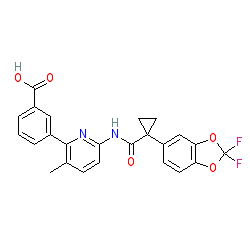GtoPdb is requesting financial support from commercial users. Please see our sustainability page for more information.
|
Synonyms: VRT-826809 | VX-809 | VX809
lumacaftor is an approved drug (EMA & FDA (2015))
Compound class:
Synthetic organic
Comment: Lumacaftor is termed a cystic fibrosis transmembrane conductance regulator (CFTR) corrector, acting to reduce mis-folding of the defective F508del mutant CFTR protein, in comparison to ivacaftor which is termed a CFTR potentiator drug. The F508del mutation is the most common cause of cystic fibrosis and accounts for approximately 60% of CF patients in Europe. Cryo-electron microscopy of CFTR-lumacaftor complexes provided insight into how the correctors operate at the molecular level, with the findings published in early 2022 by Fiedorczuk and Chen [1].
Ligand Activity Visualisation ChartsThese are box plot that provide a unique visualisation, summarising all the activity data for a ligand taken from ChEMBL and GtoPdb across multiple targets and species. Click on a plot to see the median, interquartile range, low and high data points. A value of zero indicates that no data are available. A separate chart is created for each target, and where possible the algorithm tries to merge ChEMBL and GtoPdb targets by matching them on name and UniProt accession, for each available species. However, please note that inconsistency in naming of targets may lead to data for the same target being reported across multiple charts. ✖
View more information in the IUPHAR Pharmacology Education Project: lumacaftor |
|
|||||||||||||||||||||||||||||||||||
| No information available. |
Summary of Clinical Use  |
| In 2015, a fixed-dose combination of lumacaftor plus ivacaftor (Orkambi®) was approved (EMA & FDA) for the treatment of cystic fibrosis patients aged 12 years and older carrying the F508del mutation. FDA approval for Orkambi® was expanded in October 2016 to include children with cystic fibrosis aged 6 to 11 who are homozygous for the F508del mutation. |
Mechanism Of Action and Pharmacodynamic Effects  |
| VX-809 is reported to correct protein mis-folding in one of the two transmembrane domains of the F508del-CFTR [4]. This effects partial restoration of functional CFTR channels. Combination therapy with compounds with different structure-guided mechanisms by which they correct CFTR function (e.g. Ivacaftor) may provide additional benefit in the treatment of CF [2]. |







